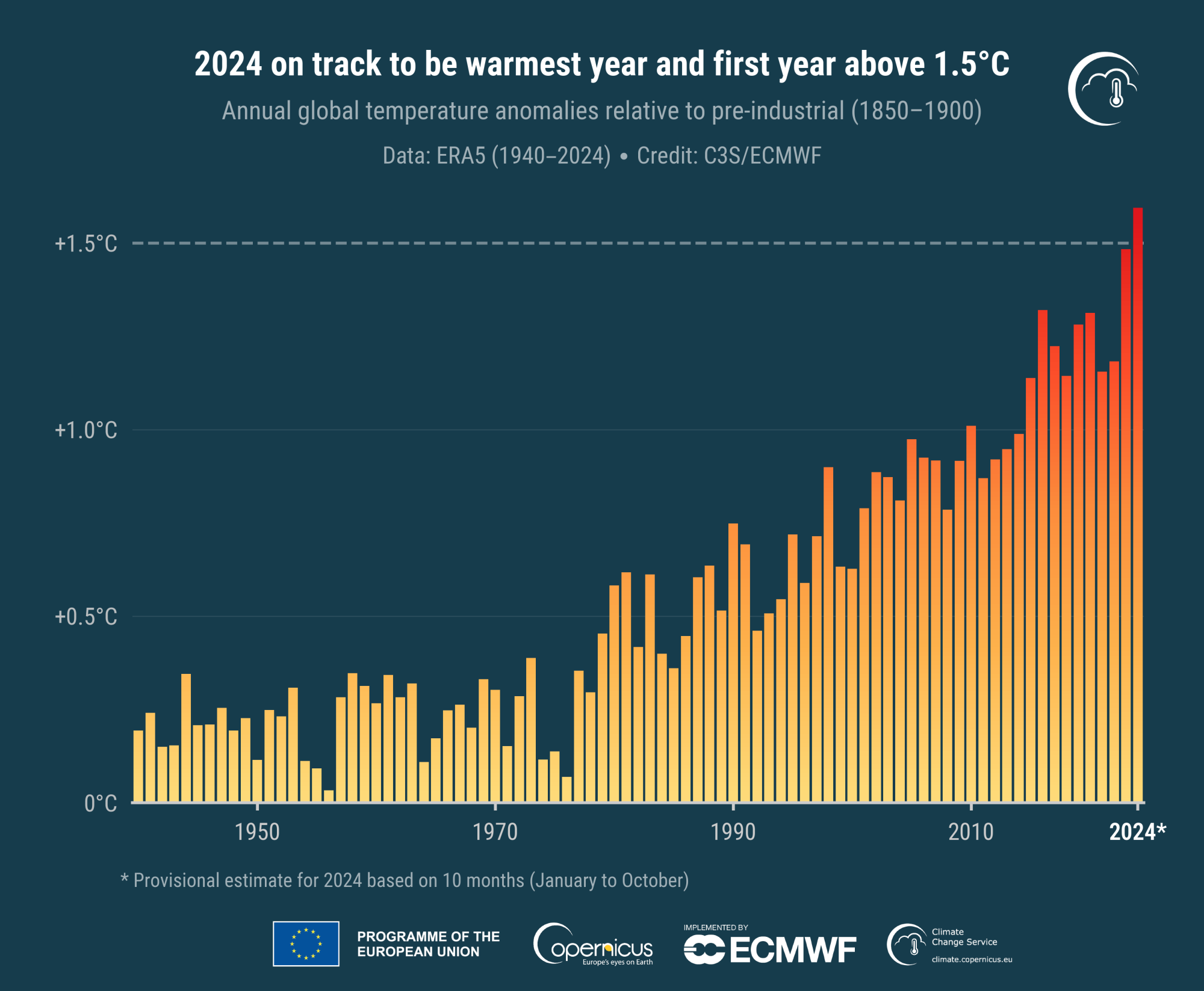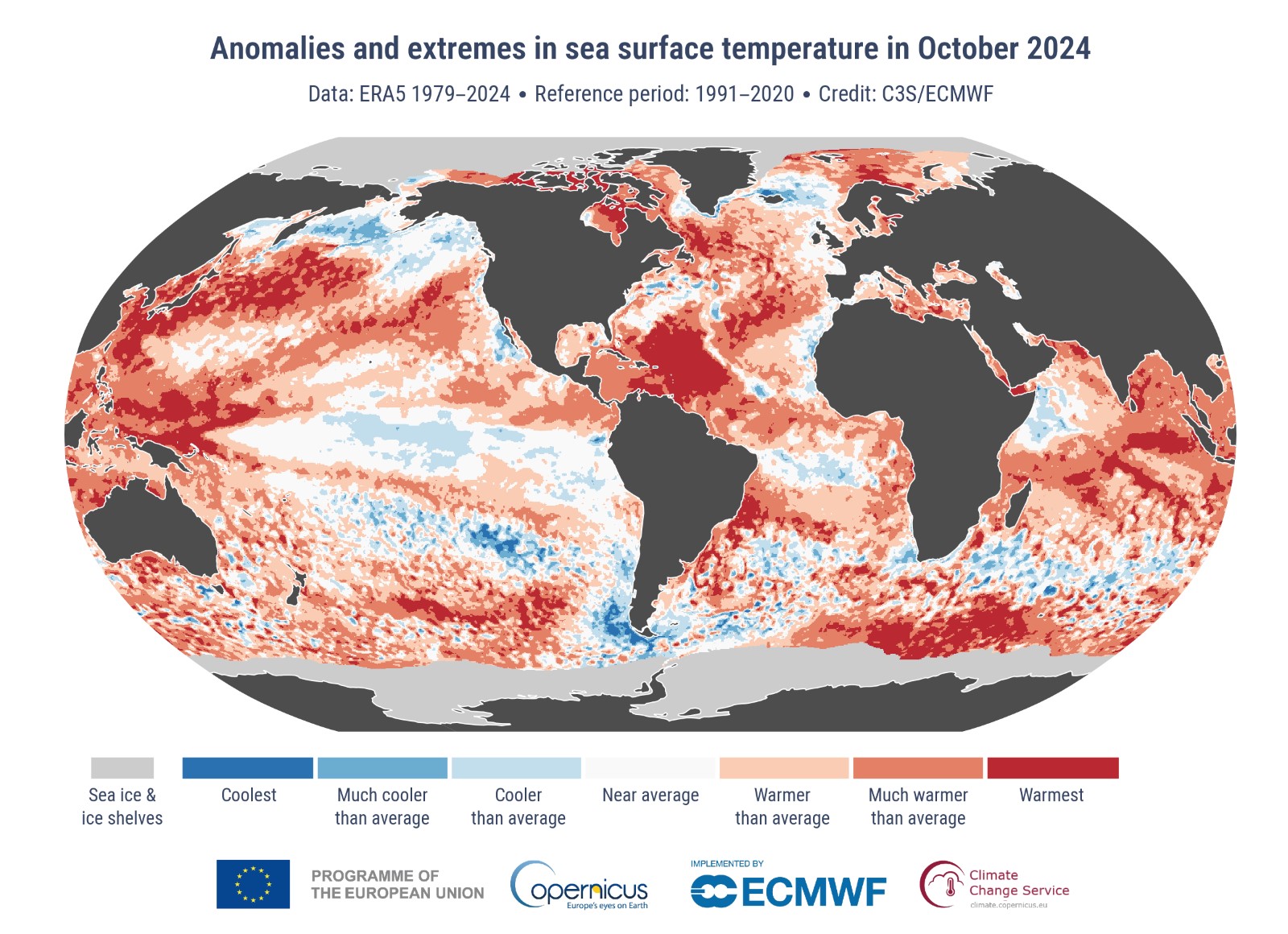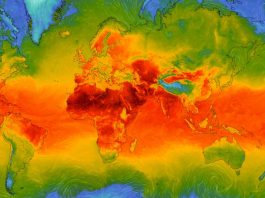As global temperatures soar, 2024 is on track to become the warmest year on record, sparking urgent calls for action on climate change.
The Copernicus Climate Change Service (C3S), a European climate monitoring organisation, recently released data highlighting alarming global temperature trends.
Their findings indicate that this year has consistently surpassed historical temperature benchmarks, setting unprecedented records for both surface air and sea temperatures.

October temperature records reflect a warming trend
October 2024 marked the second-warmest October on record globally, just behind October 2023. With an average surface air temperature of 15.25°C, October was 0.80°C above the 1991-2020 baseline.
More significantly, the month’s temperature was 1.65°C higher than pre-industrial levels, continuing a trend of higher-than-average temperatures observed for 15 out of the last 16 months.
This trend, according to C3S, suggests that 2024 will almost certainly be the warmest year on record, as temperatures would need to plummet for the remainder of the year to prevent this milestone.
This year’s temperatures have averaged 1.62°C above pre-industrial levels – a critical threshold for climate scientists.
The data implies that, barring an extreme reversal, 2024 will exceed 1.5°C above pre-industrial levels, a target limit set by the Paris Agreement to prevent severe environmental impacts.

Samantha Burgess, Deputy Director of C3S, emphasised the significance of these findings, noting that: “After 10 months of 2024, it is now virtually certain that 2024 will be the warmest year on record and the first year of more than 1.5ºC above pre-industrial levels according to the ERA5 dataset.
“This marks a new milestone in global temperature records and should serve as a catalyst to raise ambition for the upcoming Climate Change Conference, COP29.”
Regional variations in temperature anomalies
Europe experienced one of its warmest Octobers in recent history, with average temperatures across the continent at 10.83°C—1.23°C above the 1991-2020 average, making it the fifth warmest October on record.
Particularly high temperatures were observed across much of Northern Europe, with the rest of the continent also recording above-average temperatures. October 2022 remains Europe’s warmest October, with temperatures soaring to nearly 2°C above average.
Beyond Europe, temperature increases were notable in northern Canada, central and western United States, Japan, and parts of Australia. Meanwhile, Greenland and Iceland recorded temperatures below seasonal norms, marking one of the few exceptions to the warming trend.
These regional variations underscore the diverse impacts of global warming as different areas grapple with unique climate-induced challenges.
Rising sea surface temperatures signal ongoing oceanic warming
Sea surface temperatures (SSTs) also reached near-record highs. October 2024 recorded the second-highest SST, averaging 20.68°C, just 0.10°C below the record set in October 2023.
Although some areas in the eastern and central Pacific experienced slightly cooler temperatures indicative of developing La Niña conditions, SSTs remained exceptionally high across vast portions of the world’s oceans.

The impact of rising ocean temperatures is vast, influencing weather patterns, increasing the frequency of intense storms, and accelerating sea level rise.
These temperature increases contribute to oceanic imbalances, threatening marine ecosystems and impacting coastal communities globally. The warming trend observed in October highlights a concerning trajectory for ocean health.
Shrinking Arctic and Antarctic sea ice levels add to climate concerns
The warming trend also affected polar ice levels, with Arctic sea ice extent in October reaching its fourth-lowest level on record, at 19% below average.
The Barents Sea, Canadian Archipelago, and areas north of Svalbard experienced significantly lower sea ice concentrations, further stressing the vulnerability of Arctic ecosystems.
The Antarctic fared similarly, with its October sea ice extent reaching the second-lowest level ever recorded, at 8% below average.
This decline in polar ice has dire consequences, as reduced ice levels contribute to rising sea levels, increased atmospheric temperatures, and altered weather patterns worldwide.
Unstable hydrological patterns reflect climate instability
October 2024 also witnessed significant shifts in precipitation patterns, with Europe’s Iberian Peninsula, northern Italy, and parts of northern Europe experiencing above-average rainfall.
Heavy rains led to severe flash flooding in Spain’s Valencia region, resulting in over 200 fatalities, a tragic reminder of climate change’s human toll. Meanwhile, eastern Europe faced drier-than-average conditions, impacting agricultural productivity and water resources.
Other regions around the world reported similar hydrological extremes. Wetter-than-normal conditions prevailed in parts of China, Taiwan, Florida, and western Australia, while drought continued across the United States, southern Africa, and areas of South America.
The persistent drought in the US affects millions, underlining the urgent need for climate adaptation measures.
A call to action amid record-breaking temperatures
The data from C3S confirms that 2024 is likely to set a new record for the warmest year, marking a significant turning point for global climate efforts.
With temperatures now regularly surpassing 1.5°C above pre-industrial levels, climate experts and policymakers are emphasising the need for swift, coordinated action to limit further warming.
As the world prepares for the upcoming COP29 Climate Change Conference, these findings reinforce the critical importance of committing to sustainable solutions.
The evidence is clear: 2024’s record-breaking temperatures and environmental changes underscore the urgent need to address the warming planet.
With climate data confirming a worrisome trend, the world faces a stark choice between intensified climate action and the consequences of inaction.





